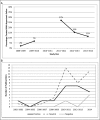Multicenter Observational Study of the Use of Nebulized Hypertonic Saline to Treat Children Hospitalized for Bronchiolitis From 2008 to 2014
- PMID: 28761004
- PMCID: PMC5525378
- DOI: 10.1542/hpeds.2017-0002
Multicenter Observational Study of the Use of Nebulized Hypertonic Saline to Treat Children Hospitalized for Bronchiolitis From 2008 to 2014
Abstract
Objectives: Among children hospitalized for bronchiolitis, we examined temporal trends in the use of hypertonic saline (HTS) and the characteristics associated with receiving this treatment.
Methods: We conducted a secondary analysis of data from 2 large, multicenter prospective cohort studies that included young children hospitalized with bronchiolitis during 5 winter seasons (2008-2014). Our outcome was receipt of HTS any time during the preadmission visit or hospitalization. For comparison with the observed trends in HTS use, we conducted a PubMed literature review of studies evaluating HTS use for bronchiolitis. We classified publications according to their assessment of HTS efficacy (positive, negative, or neutral).
Results: Among 2709 hospitalized children, 241 (8.9%) received HTS. There was marked variability in HTS use by site (0%-91%), with use more common among children admitted to the ICU than those treated on the ward (31% vs 15%). Over the study period, administration of HTS increased from 2% during the 2008-2009 season to 27% during the 2011-2012 season, but then it decreased to 11% during the 2013-2014 season. Before 2010, the number of PubMed HTS publications ranged from 0 to 3 articles per year, with all classified as either positive or neutral. The number of positive publications increased in 2010 (n = 5), whereas negative publications peaked in 2014 (n = 4).
Conclusions: Use of HTS in children hospitalized with bronchiolitis increased during the 2008 to 2012 winter seasons and then declined. These findings paralleled trends in the HTS literature, with positive articles encouraging HTS use in early years followed by a growing number of neutral and negative articles after 2012.
Copyright © 2017 by the American Academy of Pediatrics.
Conflict of interest statement
POTENTIAL CONFLICT OF INTEREST: The authors have indicated they have no potential conflicts of interest to disclose.
Figures
Similar articles
-
Utilization of nebulized 3% saline in infants hospitalized with bronchiolitis.J Pediatr. 2015 May;166(5):1168-1174.e2. doi: 10.1016/j.jpeds.2015.01.045. Epub 2015 Mar 4. J Pediatr. 2015. PMID: 25747800 Free PMC article.
-
Nebulized hypertonic saline 3% for 1 versus 3 days in hospitalized bronchiolitis: a blinded non-inferiority randomized controlled trial.BMC Pediatr. 2019 Nov 8;19(1):417. doi: 10.1186/s12887-019-1804-0. BMC Pediatr. 2019. PMID: 31699072 Free PMC article. Clinical Trial.
-
Effect of Nebulized Hypertonic Saline Treatment in Emergency Departments on the Hospitalization Rate for Acute Bronchiolitis: A Randomized Clinical Trial.JAMA Pediatr. 2017 Aug 7;171(8):e171333. doi: 10.1001/jamapediatrics.2017.1333. Epub 2017 Aug 7. JAMA Pediatr. 2017. PMID: 28586918 Free PMC article. Clinical Trial.
-
Impact of hypertonic saline on hospitalization rate in infants with acute bronchiolitis: A meta-analysis.Pediatr Pulmonol. 2018 Aug;53(8):1089-1095. doi: 10.1002/ppul.24066. Epub 2018 Jun 12. Pediatr Pulmonol. 2018. PMID: 29893029 Review.
-
Hypertonic Saline for the Treatment of Bronchiolitis in Infants and Young Children: A Critical Review of the Literature.J Pediatr Pharmacol Ther. 2016 Jan-Feb;21(1):7-26. doi: 10.5863/1551-6776-21.1.7. J Pediatr Pharmacol Ther. 2016. PMID: 26997926 Free PMC article. Review.
References
-
- U.S. Department of Health and Human Services, Health Resources and Services Administration, Maternal and Child Health Bureau. Child Health USA 2011. Rockville, MD: U.S. Department of Health and Human Services; 2011
-
- Shay DK, Holman RC, Newman RD, Liu LL, Stout JW, Anderson LJ. Bronchiolitis-associated hospitalizations among US children, 1980-1996. JAMA. 1999;282(15):1440–1446 - PubMed
-
- Pelletier AJ, Mansbach JM, Camargo CA., Jr Direct medical costs of bronchiolitis hospitalizations in the United States. Pediatrics. 2006;118(6):2418–2423 - PubMed
-
- Panitch HB. Respiratory syncytial virus bronchiolitis: supportive care and therapies designed to overcome airway obstruction. Pediatr Infect Dis J. 2003;22(suppl2):S83–S87; discussion S87–S88 - PubMed
Grants and funding
LinkOut - more resources
Full Text Sources
Other Literature Sources


